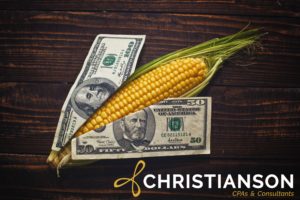The Tax Reform bill has been the topic of conversation at Christianson for the last several months and now that the bill has been signed, analyzing the changes and determining the impact on our clients is the focus of our experts.

The Tax Cuts and Jobs Act repealed the Domestic Production Activities Deduction in Section 199 as of December 31, 2017 and created a new deduction under Section 199A which is effective January 1, 2018. The purpose here is to outline the provisions in Section 199A that are specifically related to cooperatives and the impact of cooperative dividends to farmers. We have received numerous questions related to this, and with the limited guidance available, this is our effort to provide clarification. The information in this write-up is based on what is available as of January 11, 2018 and is subject to change as further regulations or guidance are released.
Deduction allowed to cooperatives
For taxable years beginning after December 31, 2017, the new Section 199A allows a specified
agricultural cooperative to deduct an amount equal to the lesser of:
- 20% of the excess (if any) of
- The gross income of a specified agricultural or horticultural cooperative, over
- The qualified cooperative dividends paid during the taxable year for the taxable year, or
- The greater of
- 50% of the W‐2 wages of the cooperative with respect to its trade or business, or
- The sum of 25% of W‐2 wages of the cooperative plus 2.5% of the unadjusted basis of all qualified property of the cooperative.
This amount cannot exceed taxable income of the cooperative for the taxable year and is only available to those cooperatives taxed as a cooperative and not those taxed as an LLC or other entity type. This new deduction for cooperatives is set to expire by December 31, 2025.
Impact on farmer/patron who sells their products to an entity taxed as an agricultural cooperative
The new 199A deduction contains a provision that allows a farmer who is married filing jointly with
taxable income less than $315,000 to take a 199A deduction equal to 20% of their net farm income less qualified cooperative distributions (QCD) plus 20% of the QCD received. This deduction is limited to the farmer’s taxable income less net capital gains. QCD includes patronage dividends, per‐unit retain allocations, and any qualified written notice of allocation, or similar amount received from a cooperative and which is includible in gross income. This deduction cannot reduce taxable income below zero or lower tax on capital gains.
The unique tax opportunity for a farmer utilizing this deduction centers around what is included as a
unit‐retain. Tax code does not provide specific language on what a unit-retain is other than the unit-retain payment has to be transacted with a patron member under a signed patron agreement with said unit‐retain not being directly tied to an earnings component of the cooperative. Private Letter Rulings issued by the IRS have allowed payments for grain and other commodity sales to be treated as unit-retains. This would seem to provide a unique opportunity today for commodity sales to cooperatives and disqualify sales to non‐coop entities.
To solidify this deduction with the necessary documentation, we believe cooperatives need to make
sure its customers are in fact patron members of the cooperative. A customer must meet the patron
requirements specified in the cooperative Articles and By‐laws. This would include written
documentation that the patron agrees that the cooperative can retain funds from their commodity sales as needed at the discretion of the cooperative. In addition, we believe the cooperative must issue 1099‐PATRs to its patrons with these commodity sales being included in Box 3 as unit retains.
Impact on farmer who sells their product to a non‐coop entity
If the farmer sells their product to a non‐cooperative business, they would not be able to take the 20% 199A deduction on those particular gross sales but rather a 20% deduction on their net farm income as related to those sales. The value differential in selling commodities to a cooperative versus a non‐coop is determined by the amount of federal income tax saved through this 199A deduction. This will vary by each farmer‐taxpayer depending upon their current and future tax planning strategies. Keep in mind the self‐employment tax and state income taxes are not impacted from this 199A deduction nor is the taxpayer’s adjusted gross income (AGI). We have completed a value analysis for farmers with varying levels of taxable income. This analysis showed the tax savings per cooperative bushels sold to range from $.05 to $.18 per bushel.
Current Status
Though this doesn’t appear to have been the intent of Congress, the current write‐up of the tax code
does allow this unique opportunity for farmer commodity sales to only cooperatives. There is no
question that it was legislatively intended for QCDs to be included in this deduction calculation to allow cooperative net income flowing to patron members as patronage dividends to receive similar tax benefits as other pass‐through entities like S‐corporations and partnerships. The legislative correction or clarification centers around if gross commodity sales should be included as unit‐retains and ultimately as QCDs. We have been told that there are Senators and stakeholders meeting now to write language to fix this oversight. Due to the specific language in the code, many do not believe this fix can be made with regulations to the code, but that legislative action would be required. There are a number of Senators committed to passing a solution to this problem, but they need to find a way to include this and secure the passage of such changes.
At this time, we are unable to conclude on a time line of a clarification or if any action will be taken. We do, however, have potential solutions that can be reviewed if your entity is a non‐coop entity that may mitigate the current tax savings value‐add cooperative commodity sales are providing to cooperative entities. We will keep you up to date on any progress made. Please let us know if you have any additional questions. You can fill out our Contact Form here or call us at 320‐235‐5937.
[button_1 text=”Contact%20Christianson%20Today!” text_size=”15″ text_color=”#ffffff” text_font=”Lato;google” text_letter_spacing=”1″ subtext_panel=”N” text_shadow_panel=”N” styling_width=”30″ styling_height=”20″ styling_border_color=”#ffffff” styling_border_size=”5″ styling_border_radius=”23″ styling_border_opacity=”100″ styling_gradient_start_color=”#1b335d” styling_gradient_end_color=”#1b335d” drop_shadow_panel=”N” inset_shadow_panel=”N” align=”center” href=”https://www.christiansoncpa.com/contact-us/”/]



